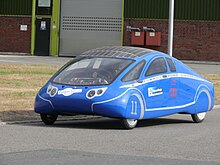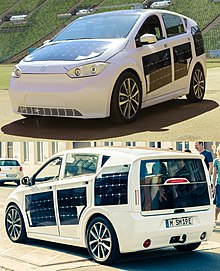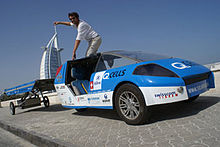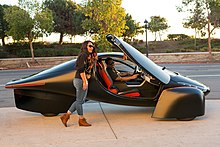
A hybrid vehicle is one that uses two or more distinct types of power, such as submarines that use diesel when surfaced and batteries when submerged. Other means to store energy include pressurized fluid in hydraulic hybrids.

The World Solar Challenge (WSC), since 2013 named Bridgestone World Solar Challenge, is an international event for solar powered cars driving 3000 kilometres through the Australian outback.

A three-wheeler is a vehicle with three wheels. Some are motorized tricycles, which may be legally classed as motorcycles, while others are tricycles without a motor, some of which are human-powered vehicles and animal-powered vehicles.

A solar vehicle or solar electric vehicle is an electric vehicle powered completely or significantly by direct solar energy. Usually, photovoltaic (PV) cells contained in solar panels convert the sun's energy directly into electric energy.

Venturi is a Monaco-based automotive manufacturer. Founded in 1984 by French engineers Claude Poiraud and Gérard Godfroy as MVS. Venturi operated for nearly sixteen years, before declaring bankruptcy in 2000. The same year, Monegasque Gildo Pallanca Pastor purchased Venturi, and decided to focus on electric-powered motors.

Nuna is the name of a series of crewed solar powered race cars that have won the World Solar Challenge in Australia seven times: in 2001, 2003, 2005, 2007, 2013, 2015 and 2017. The vehicles are built by students who are part of the "Brunel Solar Team" at the Delft University of Technology in the Netherlands, sponsored by Brunel.
The Buckeye Bullet is a series of four experimental electric cars created by students from Ohio State University as a joint project with Venturi. The cars were designed to break the land speed record on the Bonneville Speedway, a salt flat just outside Wendover, Utah, United States. The team first achieved its goal in October 2004, at 271.737 mph (437.318 km/h) for the one mile world record, repeatedly increasing the record until setting a mile world record of 307.666 mph (495.140 km/h), in 2009, and a one kilometer world record of 341.264 mph (549.211 km/h), in 2016.
Aptera Motors Corp. is an American crowd funded, pre-production startup company based in Carlsbad, California. It was originally founded in 2005 before liquidating in 2011. The company was relaunched by the original founders in 2019.
Sunswift Racing is the solar car racing team of the University of New South Wales in Sydney, Australia. The team currently holds a number of world records and is best known for its participation in the World Solar Challenge (WSC). Since its founding in 1996 by Byron Kennedy, the Sunswift team has built a total of 7 cars, the most recent of which is Sunswift 7.

A solar car is a solar vehicle for use on public roads or race tracks. Solar vehicles are electric vehicles that use self-contained solar cells to provide full or partial power to the vehicle via sunlight. Solar vehicles typically contain a rechargeable battery to help regulate and store the energy from the solar cells and from regenerative braking. Some solar cars can be plugged into external power sources to supplement the power of sunlight used to charge their battery.
Solar car racing refers to competitive races of electric vehicles which are powered by solar energy obtained from solar panels on the surface of the car. The first solar car race was the Tour de Sol in 1985 which led to several similar races in Europe, US and Australia. Such challenges are often entered by universities to develop their students' engineering and technological skills, but many business corporations have entered competitions in the past. A small number of high school teams participate in solar car races designed exclusively for high school students.

The UltraCommuter was a hybrid electric concept car first designed by the University of Queensland Sustainable Energy Group and unveiled in 2005. In 2007 the project was transferred to the Waikato University School of Engineering and further developed in conjunction with HybridAuto Pty.

A wheel hub motor, hub motor, or in-wheel motor is a motor that is incorporated into the hub of the wheel. Wheel-hub motors are commonly found on electric bicycles. Electric hub motors were well-received in early electric cars, but have not been commercially successful in modern production cars.
SolarMobil Manipal is the official Solar Car student team of Manipal University, Manipal, India. The team, founded in 2011 by a group of engineering students of Manipal Institute of Technology, is the third Indian solar car team and the first Indian team to build a passenger solar car. SolarMobil is a student project aimed at research & development of solar powered electric vehicle.

The PowerCore SunCruiser is a solar-powered road vehicle. It was created at the Bochum University of Applied Sciences to compete at the World Solar Challenge in 2013. The PowerCore SunCruiser is the fifth vehicle built by the University of Bochum and categorized as an EC vehicle class L7e, which includes full road approval. The car was presented to the public on 25 July 2013. It offers space for three persons, can reach a top speed of over 100 km/h, and is driven by two wheel-hub motors in the back wheels. Its maximum power is 8.5 kW. The vehicle's empty weight is around 340 kg, of which the batteries take around 63 kg.

The Citroën ë-Berlingo is a battery-electric version of the Berlingo range of car-based light commercial vehicle (LCV) and multi purpose vehicles (MPV) manufactured and sold by Citroën. Rebadged versions are sold by other marques within Stellantis as the Peugeot e-Partner, Opel/Vauxhall Combo-e, and Fiat E-Doblò; in addition, Toyota sells a rebadged version as the Toyota ProAce City Electric.

Stella and its successors Stella Lux, Stella Vie and Stella Era are a series of solar racing family cars, built for the World Solar Challenge in Australia, sofar winning its Cruiser Class all four times it was held – in 2013, 2015, 2017 and in 2019. Stella is considered the world’s first solar-powered family car and was given the 'Best Technology Development' Award at the 8th annual Crunchies in San Francisco in 2015. Being the only competing vehicle with a license plate, the road registration of Stella contributed to the winning score in the races. The vehicles are designed and built by "Solar Team Eindhoven" (STE) — some 26 students of different faculties of the Eindhoven University of Technology (TU/e) in the Netherlands. The group have set up a non-profit foundation to promote their concepts for practical solar vehicles for adoption on a broader scale.

Sonnenwagen Aachen is a current project by students from RWTH Aachen University and FH Aachen for the development and construction of a solar car, to participate in the World Solar Challenge in Australia. The solar car race with a length of 3022 km from Darwin in Northern Territory to Adelaide in South Australia is known to be the longest solar car race in the world and has celebrated its 30th anniversary in October 2017.
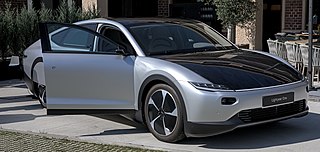
The Lightyear 0 is an all-solar-electric car by the Dutch car manufacturer Lightyear. Production was originally scheduled to start in 2021, with a starting price of €250,000 incl. VAT. The first units were delivered in December 2022. In January 2023, Lightyear announced that it was halting production of the 0 model, and that Atlas Technologies B.V., the subsidiary responsible for the manufacture of the Lightyear 0, would be allowed to go bankrupt. After a restart and new investments the manufacturer is now focusing on a more affordable model, Lightyear 2.

The Aptera solar electric vehicle (sEV) is a two-seat, three-wheeled vehicle under development by the crowd-funded relaunched company, Aptera Motors. The Aptera's primary design goal is to be the most energy efficient vehicle in mass production. The design has an aerodynamic shape and uses lightweight carbon fiber and fiberglass composite materials, wheel hub motors, and built-in solar panels to significantly extend its range.


